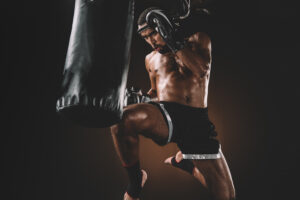Growing up, I always thought boxing was the ultimate fighting art – until I discovered Muay Thai.
This centuries-old martial art from Thailand isn’t just about throwing punches or kicks; it’s a symphony of combat movements that earned its nickname “The Art of Eight Limbs” by transforming every natural weapon of the human body into a devastating fighting tool.
The Birth of a Warrior Culture
Picture yourself in ancient Siam (modern-day Thailand), where warfare was a constant reality.
In these turbulent times, warriors developed a fighting system that would work even if they lost their swords or spears in battle.

Muay Thai Boxing Training Session
This practical approach to combat evolved into what we now know as Muay Thai.
Tales from the Tiger King
One of the most fascinating stories from Muay Thai history involves King Suriyenbodee, nicknamed the “Tiger King.” Legend tells that he would disguise himself to compete in village competitions, testing his skills against the common people. While historians debate the truth of these tales, they highlight how deeply Muay Thai was woven into Thai society, from peasants to royalty.
Beyond Punches and Kicks
The Symphony of Combat
Modern fight sports often focus on straightforward attacks, but Muay Thai is different. Each technique flows into the next like a deadly dance. The rounded kick, delivered with the shin rather than the foot, makes a sound like a baseball bat hitting a tree when it connects. This distinctive “thwack” has become synonymous with Muay Thai training worldwide.
The Clinch: The Hidden Art
While casual observers might focus on the spectacular kicks and punches, true Muay Thai masters know the clinch is where fights are often won or lost. This close-quarters grappling position, called “plum clinch,” lets fighters unleash devastating knee strikes and elbow attacks while controlling their opponent’s posture and balance.
Sacred Traditions in Modern Times
The Dance of War
Before each fight, practitioners perform the “Wai Khru” ritual – but this isn’t just for show. The movements actually warm up every muscle group used in combat while paying respect to the art’s history. Fighters wear a traditional headband called “Mongkol,” blessed by Buddhist monks, believing it provides spiritual protection during battle.
Music and Movement
Unlike Western boxing matches with their blaring entrance music, traditional Muay Thai fights are accompanied by the hypnotic sounds of the Sarama. This traditional three-piece band plays faster or slower depending on the fight’s intensity, creating an almost trance-like atmosphere in the stadium.
Training: Where Warriors Are Made
The Morning Alms
In traditional Thai training camps, students still begin their day by giving alms to Buddhist monks, a practice that teaches humility and connection to Thai culture. Then comes the real work – running before sunrise, endless rounds of pad work, clinch training until exhaustion, and strength conditioning using methods passed down through generations.
Modern Evolution
Today’s Muay Thai has adapted to contemporary fitness science while keeping its core principles. Instead of kicking banana trees (a traditional practice), fighters use modern heavy bags. But the intensity remains the same – training sessions regularly push practitioners to their absolute limits.
Impact Beyond the Ring
A Global Phenomenon
What’s remarkable about Muay Thai is how it’s maintained its authenticity while spreading globally. Unlike some martial arts that became watered down as they gained popularity, Muay Thai’s effectiveness has made it a crucial component of mixed martial arts (MMA) training. Top UFC fighters regularly travel to Thailand to improve their striking skills.
The New Wave of Practitioners
Perhaps the most surprising development in recent years is how Muay Thai has attracted people who never intend to fight competitively. Executives, students, and fitness enthusiasts have discovered that training in “the art of eight limbs” offers an unmatched combination of stress relief, fitness development, and mental fortitude.
Looking to the Future
The beauty of Muay Thai lies in its honesty – there’s no shortcut to mastery, no easy path to understanding its intricacies. Every technique has been tested countless times in real combat situations over centuries. Yet, its principles of respect, dedication, and continuous improvement resonate perfectly with modern values.
Whether you’re watching two skilled fighters trade techniques in Bangkok’s historic Rajadamnern Stadium or stepping into a Muay Thai gym for the first time, you’re connecting with a living piece of martial arts history. It’s an art form that continues to evolve while staying true to its core identity as one of the most effective and beautiful combat systems ever developed.
From its origins in ancient battlefields to its current status as a global martial art, Muay Thai represents something rare in today’s world – an unbroken line of warrior knowledge, passed down through generations, now accessible to anyone willing to step onto the path of the Thai warrior.





